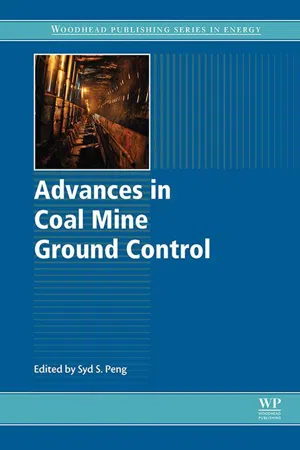
- 462 pages
- English
- ePUB (mobile friendly)
- Available on iOS & Android
Advances in Coal Mine Ground Control
About this book
Advances in Coal Mine Ground Control is a comprehensive text covering all recent advances in coal mine ground control, the most advanced subsystem of the rapidly advancing coal mining systems.This complete resource is written by Professor Syd Peng who, alongside leading experts from the world's major coal producing countries, has contributed extensively to the understanding of subsidence from underground coal mining, longwall operations and ground control in underground mines.Syd and the team of contributors bring together key advances from the past decade into one comprehensive resource that is accessible to all those studying, researching and working in the mining industry.This book is an essential text for undergraduate and graduate students of mining engineering and related programs, and a must-have reference for mining, civil and geotechnical engineers.- Written and edited by the world's leading experts on ground control in coal mining- Covers all aspects of ground control practices in coal mines- Focuses on advances over the past decade, equipping readers with the most up-to-date knowledge regarding current research and practices in the field
Frequently asked questions
- Essential is ideal for learners and professionals who enjoy exploring a wide range of subjects. Access the Essential Library with 800,000+ trusted titles and best-sellers across business, personal growth, and the humanities. Includes unlimited reading time and Standard Read Aloud voice.
- Complete: Perfect for advanced learners and researchers needing full, unrestricted access. Unlock 1.4M+ books across hundreds of subjects, including academic and specialized titles. The Complete Plan also includes advanced features like Premium Read Aloud and Research Assistant.
Please note we cannot support devices running on iOS 13 and Android 7 or earlier. Learn more about using the app.
Information
Research developments that contributed to the landscape of longwall roof support design over the past 25 years
1.1 Introduction
1.2 The Mine Roof Simulator

1.3 Longwall Shield Supports
1.3.1 Development of the two-leg shield



1.3.2 Control system technology
1.3.3 Support performance testing
Table of contents
- Cover image
- Title page
- Table of Contents
- Copyright
- List of Contributors
- Preface
- 1. Research developments that contributed to the landscape of longwall roof support design over the past 25 years
- 2. Study on the factors influencing the load capacity of shield
- 3. Structural engineering principles in coal mine ground control—the common link between empirical models, numerical models, and practical solutions
- 4. Rock failure above and below chain pillars: Implications for strength and fluid flow between goafs
- 5. Overburden response to longwall mining
- 6. Surface subsidence characteristics and damage protection techniques of high-intensity mining in China
- 7. Ground control during pillar recovery with continuous miners
- 8. Nondestructive testing of bolt support quality and stability control of coal mine roadways
- 9. Practical coal mine ground control—operator’s perspective
- 10. The use of cable bolts or ground control—current applications and future innovation
- 11. Rock failure process analysis method (RFPA) for modeling coal strata movement
- 12. Thick seam coal mining and its ground control
- 13. Experience in ground control evaluation of longwall recovery using numerical modeling and in situ monitoring
- Index